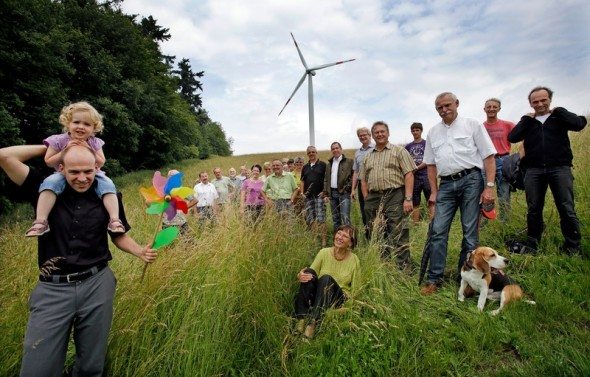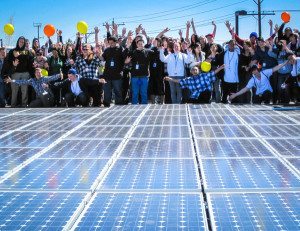This week, a major new report from the Institute for Sustainable Futures in Sydney has detailed how Australia could transition to 100 per cent renewable electricity generation by 2030, and to 100 per cent renewable everything – including industry, heat and transport – by 2050. And all for a multi-billion dollar saving to the Australian economy.
It’s a big change, of course, over a fairly short period, and will require some major adjustments to the mindsets of industry, regulators and policy makers. But where will it leave the consumer? And what role will the rising force of community energy play?

According to separate report released by the Community Power Agency on Tuesday, the questions around the role of community energy in Australia’s renewables transition, and how the consumer benefits from it, are equally important and inextricably entwined.
“The transition to 100 per cent renewables for Australia is inevitable,” said Nicky Ison – an ISF senior researcher who co-authored the independent report with Miriam Lyons – in an interview with One Step on Tuesday.
“The question that remains is how quickly that will be done and how fairly that will be done, and community energy goes to the heart of both of those things.
“If you’ve got that social licence, that public buy-in, then government and business can move quickly” to enable the shift to renewable energy, Ison said.
On the matter of fairness, she adds, the nature of community energy enterprises – being socially motivated and based on disruptive business models – will serve to keep the public interest front of mind for policy makers and regulators, ensuring that the energy revolution benefits all parties, and not just the major industry players.
Internationally, community energy has underpinned the energy transition in world-leading countries like Germany, Denmark, the UK and the US. In Germany, 47 per cent of the installed capacity is owned by citizens and communities, while in Scotland there are were just under 250 community energy projects in mid-2015.
In Australia, however, progress has been slow. Accounts from last year list upwards of 70 active groups pursuing community energy projects nation-wide, with 19 already generating, including the pioneering Hepburn Wind Farm.
To redress this, the Homegrown Power Plan makes a number of recommendations, the main one being the development of Community Powerhouses: government funded organisations that would coordinate and kick start community projects such as ‘solar gardens’ for renters, bioenergy hubs for farmers, community wind farms, and energy management and solar systems for low-income groups.
“We’re talking about Moreland Energy Foundation meets Landcare,” Ison told One Step. “We want to see a grass roots movement of that scale around renewable energy. We think there’s a real role for an organisation like that to support groups (that don’t have easy access to renewable energy) and to undertake and trial innovative projects.”
As we have reported here before, the Moreland Energy Foundation Limited (MEFL), is the Melbourne-based outfit driving an ARENA-backed project that will investigate a model for shared solar and battery storage in suburban neighbourhood micro-grids.
MEFL – which was coordinated the Darebin Solar Savers project in Melbourne, which put rooftop solar on the houses of 300 pensioners, who then pay back the cost of the system through their council rates – is working with GreenSync and Jemena to undertake the virtual trial based on historical power consumption data from medium-density Melbourne suburbs.
A second initiative suggested in the report is a Communities Clean Power Program: a collaboratively designed and “well funded” program that would deliver local renewable energy to Indigenous communities, as the “people on the front lines of climate change.”
And a third initiative is called Power Access, which is described as a non-profit retailer designed specifically to supply electricity and energy efficiency upgrades, solar PV, and more to low-income households across Australia.
“Many households were able to control their bills by buying more efficient appliances or installing solar, but this option is out of reach for many. What if there was a retailer designed to deliver clean, affordable power to those who need it most?
Another consideration, however, is how to make these things work with the existing National Electricity Market.
“At the moment in community energy, you invest and you get a dividend,” says Ison. An alternative to that model, the solar garden model – which has been popular in the US – gives you a credit on your electricity bill, offering a way for renters to access solar without having to go through their body corporate or landlord.
“We don’t see that there’s any legal reason why this can’t work in Australia. The only reason it isn’t happening is financial – and that’s the huge cost of the network.”
To this end, Ison is working with other parties to effect a rule change that would make initiatives like solar gardens more attractive and economically viable.
Also, however, the report suggests making Australia’s grid act more like the internet.
“Right now consumers are completely beholden to a clunky, centralised system and the handful of companies that dominate them,” the report says. “By shifting the electricity network business model from analog to digital, millions of us could trade renewable energy locally, instead of a few big centralised generators selling us their polluting power from far away.
The report suggests doing this via an Energy Transition Agency, that would help network companies to transform themselves into local energy trading platforms.
“Imagine a website that lets you buy your electricity from your neighbour, or get it from the nearby solar garden that you part-own, or the wind turbine at your friend’s farm at the edge of town. Think eBay, but for local energy,” it says.
“We think its (a model) worth exploring,” Ison told One Step. “(The networks) could clip the ticket on the way through. …It’s the model that New York is pursuing, and the centre piece of the process is about reforming the utilities to enable local energy.”
She adds, “I should note that it’s easier over there because it’s still vertically integrated. But we think it can be done here.”
Overall, Ison says, the message to the energy industry incumbents is that “we’re in the midst of an energy transition. It’s going to be messy, but we can make it less messy.”
This article was originally published on RE sister site One Step Off The Grid. To sign up for the weekly newsletter, click here.








